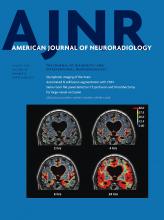Table of Contents
Perspectives
Practice Perspectives
General Contents
- Intrathecal Use of Gadobutrol for Glymphatic MR Imaging: Prospective Safety Study of 100 Patients
The authors performed a prospective safety and feasibility study in 100 consecutive patients undergoing glymphatic MR imaging from September 2015 to August 2018. Short- and long-term serious and nonserious adverse events were registered clinically and by interview after intrathecal administration of 0.5 mL of gadobutrol (1.0 mmol/mL) along with 3 mL of iodixanol (270 mg I/mL). One serious adverse event (anaphylaxis) occurred in a patient with known allergy to iodine-containing contrast agents (1%). The main nonserious adverse events during the first 1–3 days after contrast injection included severe headache (28%) and severe nausea (34%), though the frequency depended heavily on the diagnosis. They conclude that intrathecal administration of gadobutrol in conjunction with iodixanol for glymphatic MR imaging is safe and feasible.
- Convolutional Neural Network for Automated FLAIR Lesion Segmentation on Clinical Brain MR Imaging
This convolutional neural network was retrospectively trained on 295 brain MRIs to perform automated FLAIR lesion segmentation. Performance was evaluated on 92 validation cases using Dice scores and voxelwise sensitivity and specificity, compared with radiologists' manual segmentations. The authors' model demonstrated accurate FLAIR lesion segmentation performance (median Dice score, 0.79) on the validation dataset across a large range of lesion characteristics. Across 19 neurologic diseases, performance was significantly higher than existing methods (Dice, 0.56 and 0.41) and approached human performance (Dice, 0.81).
- The Interpeduncular Angle: A Practical and Objective Marker for the Detection and Diagnosis of Intracranial Hypotension on Brain MRI
MRIs of 30 patients with intracranial hypotension and 30 age-matched controls were evaluated by 2 neuroradiologists for classic findings of intracranial hypotension and the interpeduncular angle. Group analysis was performed with a Student t test, and receiver operating characteristic analysis was used to identify an ideal angle threshold to maximize sensitivity and specificity. The interpeduncular angle had excellent interobserver reliability (intraclass correlation coefficient value = 0.833) and was significantly lower in the intracranial hypotension group compared with the control group (25.3° versus 56.3°). There was significant correlation between the interpeduncular angle and the presence of brain stem slumping. With a threshold of 40.5°, sensitivity and specificity were 80% and 96.7%, respectively.
- One-Stop Management with Perfusion for Transfer Patients with Stroke due to a Large-Vessel Occlusion: Feasibility and Effects on In-Hospital Times
The authors report the first 15 consecutive transfer patients with stroke with externally confirmed large-vessel occlusions who underwent flat panel detector CT perfusion and thrombectomy in the same room. Preinterventional imaging consisted of noncontrast flat panel detector CT and flat panel detector CT perfusion, acquired with a biplane angiography system. The flat panel detector CT perfusion was used to reconstruct a flat panel detector CT angiography to confirm the large-vessel occlusions. After confirmation of the large-vessel occlusion, the patient underwent mechanical thrombectomy. Fifteen transfer patients underwent flat panel detector CT perfusion and were treated with mechanical thrombectomy from June 2017 to January 2019. The median time from symptom onset to admission was 241 minutes. Median door-to-groin time was 24 minutes. Compared with 23 transfer patients imaged with multidetector CT, time was reduced significantly (24 minutes versus53 minutes).
- Distal Balloon Angioplasty of Cerebral Vasospasm Decreases the Risk of Delayed Cerebral Infarction
A group of 392 patients was analyzed (160 before versus 232 after January 2015). Distal balloon angioplasty was associated with the following: higher rates of angioplasty (43% versus 27%) and intravenous milrinone (31% versus 9%); lower rates of postangioplasty delayed cerebral infarction (2.2% versus 7.5%) and new angioplasty (8% versus 19%) independent of the rate of patients treated by angioplasty and milrinone; and the same rates of stroke related to angioplasty (3.6% versus 3.1%), delayed cerebral infarction (7.7% versus 12.5%), mortality (10% versus 11%), and favorable outcome (79% versus 73%). The authors conclude that distal balloon angioplasty is safe and decreases the risk of delayed cerebral infarction and the recurrence of vasospasm compared with conventional angioplasty. It fails to show a clinical benefit possibly because of confounding changes in adjuvant therapies of vasospasm during the study period.
- Posterior Fossa Dural Arteriovenous Fistulas with Subarachnoid Venous Drainage: Outcomes of Endovascular Treatment
Twenty-six patients treated endovascularly for posterior fossa dural AVFs, type III, IV, or V, were included in this study. One hundred percent of the dural AVFs were occluded. A transarterial approach was performed in 23 dural AVFs; a combined transarterial and transvenous approach, in 2 dural AVFs; and a transvenous approach alone, in 1 dural AVF. The middle meningeal artery was the most common artery chosen to inject embolic liquid (12/26). Procedure-related morbidity was 15.4% at 24 hours, 7.7% at discharge, and 0% at 6 months. Procedure-related mortality was 0%. The authors conclude that endovascular treatment offers high occlusion rates for posterior fossa dural AVFs with low morbidity and mortality rates.



